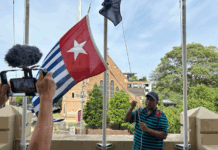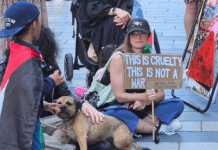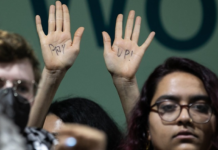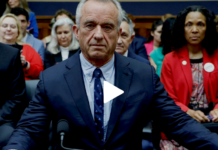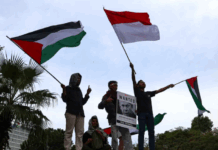
By Muhammad Shehada
Since the onset of its genocide, Israel has persistently pushed a narrative that the famine devastating Gaza is not of its own making, but the result of “Hamas looting aid”.
This claim, repeated across mainstream media and parroted by officials, has been used to deflect responsibility for what many human rights experts have called a deliberate starvation campaign.
Even after Israel fully banned the entry of food, water, fuel, and medicine on March 2, Tel Aviv continued to maintain that Hamas looting, not Israeli policy, was to blame for the humanitarian catastrophe.
- READ MORE: Israel kills dozens of Palestinians at US-backed aid hubs in Gaza
- Other Israel’s war on Gaza reports
But that narrative has now been discredited by Israel’s internal reporting. Last week, the Israeli military admitted internally that out of 110 looting incidents they documented, none were carried out by Hamas.
Instead, the looting was done by “armed gangs, organised clans” and, to a lesser extent, starved civilians.
Those very gangs and clans are backed by Israel; they enjoy full Israeli army protection and operate in areas Israel deems “extermination zones”, where any Palestinian trying to enter would be killed or kidnapped on the spot.
The gangs had vanished during the two-month ceasefire but conveniently re-emerged as soon as Israel was pressured into allowing a limited trickle of aid to enter. The timing is no coincidence; Israeli policy has deliberately weaponised anarchy to preserve the conditions for starvation.
This pushed even the UAE to strongly condemn Israel after the army forced an Emirati aid convoy to drive through a “red zone” where Israel-backed gangs looted 23 out of 24 trucks.
So why does Israel continue to cling to a demonstrably false narrative while openly engineering a looting crisis through its proxies? Because the myth of “Hamas looting” serves a critical strategic purpose: to whitewash and legitimise a new plan that institutionalises starvation for blackmail, ethnic cleansing, collective punishment, and mass internment through a shell Israeli organisation.
This is coupled with another alarming tactic of recruiting warlords, drug dealers, and criminals to create a puppet “anti-terror” force.
Israel’s looting myth
The “looting” talking point is devoid of any logic, as Hamas would be able to do very little with thousands of tons of looted aid.
Israel and US Ambassador Mike Huckabee both claim Hamas uses the looted aid to buy new weaponry. But where would they buy such weapons from when Gaza is fully sealed off by Israel, and Rafah — the city of smuggling tunnels — is under full Israeli control?
Israel claims Hamas sells looted aid on the black market. But, again, what would they do with the money? Virtually nothing is allowed into Gaza except a trickle of food.
Israel also claims Hamas uses looted aid to recruit new militants, but Hamas doesn’t operate this way. The group depends on utmost secrecy and discipline in its operations.
Each new member passes through a long process of vetting, training, and tests to minimise the risk of infiltration. It would compromise Hamas to recruit people openly, whose only attachment to the group is bread rather than ideological commitment.
Perhaps most damning is that Israel has never captured a single instance of Hamas looting aid, despite subjecting Gaza to the most meticulous surveillance on earth. Israeli predator drones cover every inch of the enclave every minute of the day, yet there is nothing to show for Israel’s claims.
Hamas is also aware that hijacking and looting aid trucks could lead to Israel bombing the vehicles and diverting them from their predetermined route.
The Israeli army has done this on countless occasions when it fired at or bombed humanitarian convoys under the pretext that Hamas policemen came near the trucks. Ironically, those law enforcement officials were actually trying to prevent looting when they were targeted.
Israel’s allies reject the narrative
Israel’s strongest supporters have refuted the “Hamas looting” claim. President Joe Biden’s humanitarian envoy, David Satterfield, admitted in February of last year that “no Israeli official has . . . come to the administration with specific evidence of diversion or theft of assistance delivered by the UN”.
Satterfield reiterated last Tuesday that Israel has never privately alleged or offered evidence of Hamas stealing aid from the UN and INGO channels. Israel’s ambassador to the EU, Haim Regev, said in mid-October 2023 that “there’s no evidence EU aid went to Hamas”.
Cindy McCain, World Food Programme’s chief and widow of one of the most pro-Israeli GOP senators, forcefully rejected Israel’s narrative on Sunday, saying that looting “doesn’t have anything to do with Hamas . . . it has simply to do with the fact these people are starving to death”.
The Washington Post, meanwhile, reported last week that “Israel has never presented evidence publicly or privately to humanitarian organisations or Western government officials to back up claims that Hamas had systematically stolen aid brought into Gaza”.
An internal memo jointly drafted by UN agencies and 20 INGOs in April, and viewed by The New Arab, stated that “there is no evidence of large-scale aid diversion”.
Gangs and scarcity are responsible for looting
While Israel failed to show any evidence of Hamas stealing aid, the only documented organised systematic looting happening in Gaza right now is by Israeli-backed criminal gangs who enjoy full protection from the Israeli army, according to the Washington Post, Financial Times, Ha’aretz, and the UN.
A UN memo said these gangs established a “military complex” in the heart of Rafah after Israel fully depopulated the city. Humanitarian officials say the looting often happens right in front of Israeli troops and tanks, less than 100m away, who take no action until the local police arrive, with Israeli troops then opening fire at them.
Israel not only provides protection and backing to these criminal gangs but has created the perfect conditions for looting to thrive through scarcity and a collapsing state of law and order.
Currently, a single bag of wheat flour sells for about 1,500 NIS ($425), which makes it profitable for gangs to loot and sell on the market. These astronomical prices are driven by scarcity after Israel banned all food from entering Gaza for nearly 80 days, then allowed less than 20 percent of what Gaza needs on a normal day for basic survival after intense international pressure.
During the ceasefire, however, when Israel was allowing 600 trucks to enter per day, prices went back to normal and looting disappeared because it was no longer profitable due to the abundance of food, and because the police were able to resume their work.
Manufactured crisis to advance genocide
The engineered looting crisis has long served as a convenient excuse to cover up the deliberate weaponisation of starvation against Gaza’s entire population, allowing Israel to distract from its restrictions on the entry of aid and the spread of famine by saying Hamas is to blame for stealing aid.
But now, this manufactured crisis is serving a second objective: to justify a dystopian ‘aid plan’ Israel is implementing in Gaza that has been condemned and boycotted by every UN agency and humanitarian organisation working in the enclave, as well as donor countries.
A joint UN-INGO memo warned that the Gaza Humanitarian Foundation would facilitate the use of aid for forcible expulsion, by telling Gazans the only way they can receive food is by moving south to Rafah on Egypt’s border.
GHF, which Israeli opposition leaders said was an Israeli shell funded by Mossad, began its operations last Tuesday after being rocked by two scandals in one day.
GHF’s CEO had resigned on Sunday in protest of the organisation violating the principles of humanitarianism, while the organisation shut down its registered headquarters in Switzerland as soon as Swiss authorities launched an investigation.
Images coming out of the GHF’s militarised aid distribution site were immediately likened to concentration camps, where hundreds of emaciated Gazans were crowded into metal cages like cattle under the boiling sun, surrounded by armed US mercenaries, Israeli troops, and sand dunes.
Alarmingly, people who received aid noted the presence of Arabic speakers in addition to American mercenaries. Last week, the Israel-backed Islamic State-linked gang leader Yasser Abu Shabab emerged in Rafah again after a long disappearance.
Abu Shabab, a drug dealer and wanted criminal previously arrested multiple times by the local police, was the primary suspect in the systematic looting of aid under Israeli protection. This time, however, he emerged in a brand new uniform and military gear and started a Facebook page promoting himself in English and Arabic to mark a new “anti-terror” force operating in Israel-controlled Rafah.
Additional pictures viewed by The New Arab showed multiple armed men dressed in the same uniform as Abu Shabab armed with M-16s standing in front of a humanitarian convoy.
The unravelling of Israel’s “Hamas looting” narrative lays bare a chilling truth: starvation in Gaza is not collateral damage — it is a calculated weapon in a broader campaign of collective punishment and displacement.
By cultivating chaos, empowering criminal gangs, and then manipulating the humanitarian crisis they manufactured, Israel seeks to maintain extreme restrictions on aid, while externalising blame and avoiding accountability.
It is the machinery of genocide disguised in bureaucratic language and carried out under the watchful eyes of the world.
Muhammad Shehada is a Palestinian writer and analyst from Gaza and the European Union affairs manager at Euro-Med Human Rights Monitor. The article was first published by The New Arab. On X at: @muhammadshehad2



